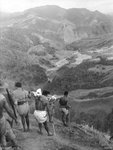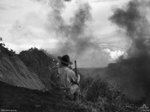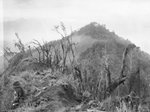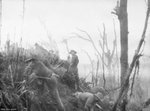Wildcat
Major
Here's a good outline to those unfamiliar with this campaign fought over some brutal terrain..
Shaggy Ridge Operations: Australian War MemorialShaggy Ridge is a six and a half kilometre long razor-backed ridge that is the highest feature in the Finisterre Mountains in north-eastern New Guinea. The ridge rises between the valleys of the Mene and Faria Rivers and ends at Kankiryo Saddle - a bridge of land separating the Faria Vallyey from the Mindjim River Valley. In 1943 Shaggy Ridge was the site of main Japanese defensive position blocking access from the Ramu Valley to the track and road network that joined it with the north coast. Operations by the 7th Australian Division in September and October 1943 and caused the Japanese the withdraw from the Ramu Valley and the lower features of the Finsterres and consolidate their defences around Shaggy Ridge. The ridge was named after Captain Robert "Shaggy Bob" Clampett of the 2/27th Battalion whose company was the first to reconnoitre its approaches.
Initially, orders from II Australian Corps for 7th Division to limit its operations to a scale that could be maintained by the limited supplies available prevented action being taken to capture Shaggy Ridge, but by late December sufficient supplies were available to conduct a limited operation to secure a foothold on the southern end of the ridge around a knoll called the Pimple. B Company of the 2/16th Battalion attacked just after 9am, following an intensive aerial and artillery bombardment of the Japanese positions. Clambering up the precipitous slopes, still supported by artillery fire, the Australians quickly captured the Pimple and pushed on for another 100 metres to capture the next knoll along the ridge. B Company was subsequently relieved by D Company, which renewed the attack the next day and captured the next two knolls along the ridge, the last being named McCaughey's Knoll after the commander of the leading platoon. The Japanese counter-attacked that afternoon but were beaten off and thereafter were content to shell the Australian's newly won position with a mountain gun.
The next major assault along Shaggy Ridge - codenamed Operation Cutthroat - would be launched by the 18th Brigade with the aim of capturing the entire feature, including Kankiryo Saddle. The plan involved the brigade's three battalions converging on the saddle from three different directions. The 2/12th would advance from Canning's Saddle, east of Shaggy Ridge, and attack Kankiryo Saddle via two well-defended knolls on the northern end of Shaggy Ridge known as Prothero 1 and 2; the 2/9th would attack northwards along Shaggy Ridge itself; and the 2/10th would advance along Faria Ridge, which lay to the east of ShaggyRidge and joined it at Kankiryo Saddle. All three battalions would be supported by artillery and Allied aircraft.
The 2/10th and 2/12th Battalions commenced their approach marches on 19 January; the 2/12th in particular had a great deal of precipitous country to traverse and was not scheduled to attack for another two days. On the 20th the 2/10th attacked Japanese positions on Cam's Saddle in order to fight their way onto Faria Ridge but were held up by stubbourn Japanese resistance. The operation began in earnest the next morning with the 2/12th clambering up the steep slopes below Prothero 1 and A Company of the 2/9th doing the same on the eastern side of Green Snipe's Pimple, the highest point on both McCaughey's Knoll and Shaggy Ridge. The unexpected direction of these attacks, up slopes the Japanese obviously regarded as almost impassable, allowed the Australians to quickly establish a foothold on both features and they were secured by the end of the day. Their new occupants, however, had to withstand several counter-attacks and persistent and accurate artillery bombardment. The 2/10th's own artillery support had helped it to force its way onto Faria Ridge earlier in the day and by nightfall it had advanced to within a kilometre and a half of Kankiryo Saddle. 22 January resulted in another day of hard fighting. The 2/12th Battalion pushed south along Shaggy Ridge to capture Prothero 2 while the 2/9th pushed north to take the rest of MacCaughey's Knoll. As the two battalions readied themselves to meet the inevitable nightime counter-attacks, less than a kilometre separated them. Next morning patrols encountered little opposition and by midday the 2/12th and 2/9th had linked up; all of Shaggy Ridge was in Australian hands. The 2/10th had attacked both north and south along Faria Ridge on 22 January and continued to do so on the 23rd. In the north it was held by another strong Japanese position that was not occupied until late on the afternoon of 24 January.
By this time, the remaining Japanese stronghold in the area was atop a knoll north east of Kankiryo Saddle known as Crater Hill. It was the former Japanese Regimental Headquarters and the defences were well-site and constructed. It was decided that rather than attack this position the 18th Brigade would contain it with patrols and then pound it with bombs and artillery to inflict sufficient casualties that a final assault could be conducted at minimal cost. This siege lasted until 1 February when a company from each opf the 2/9th and 2/10th Battalions advanced up Crater Hill to find it devastated and unoccupied.
The capture of Shaggy Ridge cost the 18th Brigade 46 killed and 147 wounded and inflicted over 500 casualties on the Japanese, including 244 confirmed deaths. It cleared the way for an advance across the Finsterres to the northern New Guinea coast to link up with the Australian forces advancing from the east and thus complete the capture of the Huon Peninsula.

































